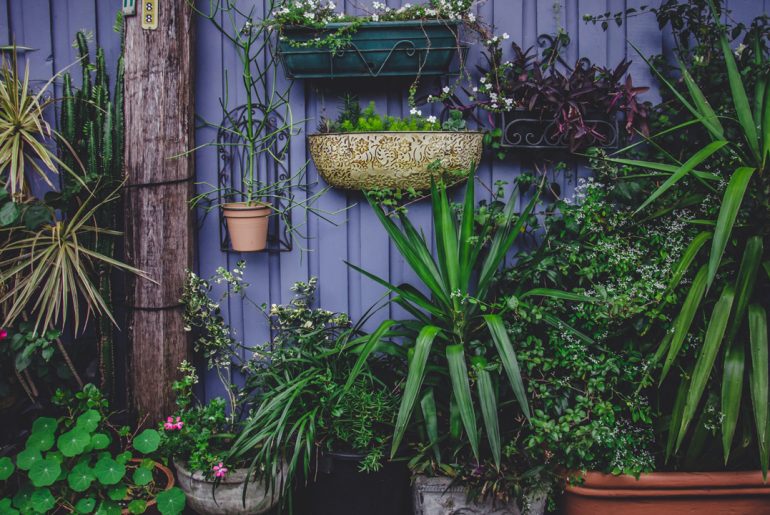Or a team leader, manager, developer, tester, or just a better person. That’s because taking care of a plant is a bit like looking after a project and can give you a sense of a peaceful, satisfying ritual. Some people connect with the idea that caring for plants is about nurturing yourself by creating an environment that benefits you in many different ways. Little greenery helps clean indoor air by absorbing and metabolizing gases into oxygen and other, less toxic compounds. It also takes away your stress and converts it into creative productivity.
Bonus points: some plants, apart from being a decoration, have a pleasant smell. Others — like herbs, fruits, and vegetables — give you something to munch on. And growing something delicious is easier and more gratifying than you might expect!
This is just the beginning of the list of benefits of growing a green friend. Let’s see how doing so can bring another perspective to the designer’s work.
Research
Plants come in every size, shape, colour, and texture imaginable. They originate from different natural habitats and thus have distinct requirements. Suppose you want to grow a happy plant. In that case, you need to do some P.I. work and discover the factors that help create the illusion of the native environment of your plant and therefore remove the friction.
Like it or not, as a creator, you manage dreams, expectations, and resources to satisfy the needs of the client, users (viewers), your team, your company, your friends, significant others, and — last but not least — yourself. That’s your product’s environment, and you are doomed to identify its characteristics as well as risks and opportunities associated with it. Even the most selfless stakeholder has a voice to be heard and nurtured — that’s one of the critical elements of a successful project.
Exercises in empathy
Plants are super communicators. Once they have adapted to a specific place, they can’t migrate far. They have to use electrical signals, chemical substances, and colours to talk with their buddies, attract and repel other creatures, or command anything to another part of the flower. They have to be precise to survive.
You might think that communication with people is more straightforward than with plants. Yes, they can talk, write, laugh, make faces and gestures. But everyone speaks a different language, filled with their both aware and subdued memories, emotions, connotations, and biases. Some of them won’t tell you anything. They might be ashamed of their limitations, unaware of their problems, or they might assume that you already know everything. En masse, all these signals create noise from which you must make as much sense as possible.
However, you can’t make much sense of the internal communication of potted plants and backyard gardens. You can’t impose your diet, schedule, or habits on your plants. You also cannot teach them your language. You can only look for the effects of your caring. The more sensitive you become about those tiny visual cues, the quicker you can react, the happier your plant is, and the better it looks. This practice should help you be more observant about your users, even those distant and ordinary ones, your actions, and the whole world.
Small things can grow into something big
Even the most incredible trees of the world started with a humble seed. Don’t underestimate any idea, sprout, or gesture because it can evolve into something absolutely fabulous.
Exercises in aesthetics
There are so many types to choose from: air plants, succulents, cacti, bromeliads, bulbous plants, orchids, trees, ferns, grasses, palms, climbers, carnivorous, or foliage plants. And even if you take just one of the groups, the aesthetic diversity of its representatives is humongous. You can’t really say that a prickly pear cactus looks odd and carrots are boring.
Well, you can, but that would be unjust. The appearance of each species results directly from the conditions of the ecosystem. In other words: appearance follows function. It’s hard to blame nature for that. Recognizing those subtleties should make you more open and curious about different types of beauty but also sharpen your analytical skills.
Give it some space
Even the smallest flora representative needs some space to collect nutrients, grow, and bloom — even if they like hanging out in groups. Some of them grow very large, some have their favorite companions, others just don’t want to be touched and need some extra room around them. Yet, it’s about the physical area and being attentive, but not overprotective. Long story short — your plant might freak out and die trying to adjust to all the excess treatment.
Your stakeholders also need some space to operate. Overdo with micromanagement, updates, closeness, visual clutter, or another type of pressure, and everyone will hide away instead of flourishing. Give and take the right amount of support and quality. And don’t be afraid of negative space. A little air makes everything stand out and shine.
Things take time
Most plants require a particular number of days, months, or even years to produce flowers and fruit, and you can’t speed this up, nor do all the work by yourself. And it’s a bit hazardous to drastically change the plant’s setting. Once it has adapted to certain conditions, it may use up all the energy to adjust to the continual revolutions instead of gradual, refreshing evolutions.
Things just take time to process, some more than others. Design documentation won’t emerge in the blink of an eye. The app won’t be developed overnight before it moves into the adoption phase. Then you need to hold your horses before you make each next big move. After all, every new experience is bound with friction and discomfort since we hang onto things we know and understand, even if they’re imperfect or irritating.
Scaling up can be a challenge
You might think that if you can keep a few plants alive and in good shape, you can fill your whole room with green. However, before you go on a shopping spree, calculate your resources wisely. Each plant needs some space, light, pot, soil, treillage, and your regular attention. Lastly, you should quarantine any new captures for at least a few weeks to ensure they won’t infect the rest of the pact with pests, fungi, or diseases.
Even if you’re not dealing with mould or aphids, adding too many elements of any kind without proper preparations can shake up your world. It can stun the management, frighten your stakeholders from sharing your idea, or bungle the whole job.
Girl gone wild
Even the most popular houseplant available in the local supermarket retains its self-preservation instinct. Leave your plant unattended, and it will activate a set of behaviours that ensures its survival. It might waste away and shed some leaves, lose its shape, or develop in a deformed, tortuous way. Or grow too large, invading the whole area — like plants reclaiming abandoned spaces.
Your stakeholders also need some sense of direction. The excitement of keeping an eye on the project and preventing scope creep, messy documentation, or misleading design, lacking any structure. That feeling that everyone is motivated, knows their responsibilities, understands their actions and consequences. Or that the app or the system you hand over will guide the user by the hand and won’t go berserk.
Be cautious about diseases and pests
A miniature grub can start a massive population of pests that can destroy your gardening efforts in no time. Similarly, a minor lapse can cause a chain reaction of misalignments, collisions, and doubts in your project. It all can start with a tiny setback, a hint of hesitation, or a weirdly configured text style that can evolve into an utter mess if unattended. Being mindful can help you recognize those little bugs and pacify them before they wreak irreversible havoc.
Sh*t can be helpful
Okay, using the real manure at home will be unpleasant and unsanitary. Still, a dose of natural compost once in a while is the best nutrient for a house plant. One needs to remember to be cautious with conditioning as the plant won’t digest all the goodness.
Some situations might not smell or feel great, but they can be really beneficial when used to your advantage. All in all, you should seek volatility and disorder. All the stressors, noises, failures, and disappointments can strengthen your skills, your design, and the team.
But bear in mind that not everything is meant to become antifragile.
Death happens
Sometimes composting is the only valuable option as there’s nothing more you can do to save your green friend in its original shape. In some cases, it means dividing the stem into sections to let them sprout and start some new lives.
Your projects are also allowed to die regardless of your efforts. Your products, services, features, solutions — ideas of any size, shape, and condition — might just reach their peak and change direction. The same is with users or colleagues — they might come and go. And then come back again. And that’s how the natural cycle of life works. It’s up to you how you are going to get through those experiences.
Turn your face to the light
Chase things that inspire and support your personal and professional growth the way greenery is constantly reaching for the food with all its parts. Be bold about showing your worth and sharing your work and knowledge just like the plants spread their scent, pollen, and seeds. Bathe in the light of satisfaction and appreciation.
Let’s wrap this up
As soon as you take up growing plants indoors, you literally start leading a greenery project that turns your living or working space into a happier, healthier place to be. This may be scary, and for those who don’t identify as having a green thumb, this level of responsibility can be discouraging or even daunting, especially if they’ve ever accidentally killed a plant in the past. But the benefits of cultivating a plant far outweigh its decorative function.
It’s like having a green mentor that improves your discipline, mindfulness, artistic taste and enhances empathy and compassion as you consider the ways to keep it healthy and happy. And just like with plants — happy and healthy stakeholders make you (and the whole project) joyful.
Have more gardening or design ideas? Just get in touch via justyna@makimo.pl or WhatsApp.
And if you need a an observant and creative design team…
Let’s talk!Head of UX who loves making sense of noise, searching for trends and inspirations, and exploring the humane face of technology. Justyna shares her passion not only within Makimo but also as a lecturer at UEHS, Warsaw, and a co-host of the Let the Tech Out podcast. She writes her own story not only using words and pixels but also brush strokes, seams, knitting stitches, yoga asanas and running miles.



